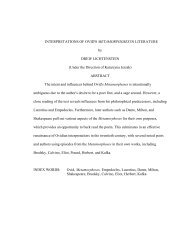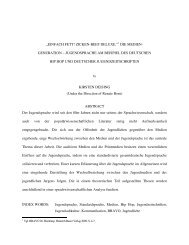RED BOAT TROUPES AND CANTONESE ... - University of Georgia
RED BOAT TROUPES AND CANTONESE ... - University of Georgia
RED BOAT TROUPES AND CANTONESE ... - University of Georgia
Create successful ePaper yourself
Turn your PDF publications into a flip-book with our unique Google optimized e-Paper software.
I have not seen ritual playlets performed at permanent theatres in Hong Kong in the<br />
2000s, but I have seen them staged at makeshift halls before main features at local festivities.<br />
Some playlets were performed consecutively. Seeing different shows with many performers<br />
wearing colorful bright costumes on stage in a matter <strong>of</strong> several minutes at the Shek O<br />
community festival in Hong Kong Island, and at the Feast <strong>of</strong> the Ghost at Kowloon City in Hong<br />
Kong, was certainly enjoyable for me. I seemed to go back in time and watch what my<br />
grandmother saw 90 years earlier in the village Sum Zeng (Deep Well), on the island <strong>of</strong> Coeng<br />
Zau (Long Island), in the estuary.<br />
Unlike opera seria in the West, Cantonese operas usually have happy endings. Even with<br />
the tragic nature <strong>of</strong> The Butterfly Lovers, both lovers who die at the end and were unable to get<br />
married live happily ever after as butterflies that dance in the beautiful woods. And in the well-<br />
known Tong Dik Sung tragedy Princess Coeng Ping, the princess and her husband-to-be, both<br />
committed suicide, and both later reunited happily with the princess’s deceased mother in<br />
heaven. In many Cantonese operas, the characters are everyday people –“Verismo” is found in<br />
the plots <strong>of</strong>ten. And, <strong>of</strong> course, the moral teaching <strong>of</strong> each play praises good people and<br />
punishes bad ones.<br />
Before the establishment <strong>of</strong> the Republic during Qing dynasty, simple scripts were used<br />
for operas <strong>of</strong> the Eighteen Standard Plays. As opera reached its golden age between 1911 and<br />
1923, with frequent performances and with some large-scale troupes <strong>of</strong> a hundred fifty people,<br />
copies <strong>of</strong> scripts could not be distributed to all the staff. Out-line plays (tai kong hei) with<br />
simple plots and entrance points for characters were posted on a large board backstage with<br />
characters only understood by people <strong>of</strong> the trade. The performer used his or her improvisational<br />
skills to speak the dialogue and sing the aria. This was a time when the details <strong>of</strong> conversations<br />
40






